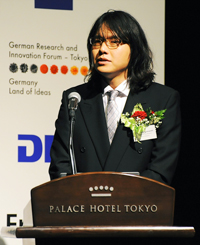
Program-Specific Associate Professor Itaru Imayoshi, who belongs to both the Hakubi Center for Advanced Research and the Institute for Virus Research, has been awarded top honors in the German Innovation Award, Gottfried Wagener Prize 2014 for his research on "optogenetic control of neural stem cells in the adult brain".
Named after a German scientist with close ties to Japan, the Gottfried Wagener Prize was established by innovation-focused corporations in Germany to promote industry-academia collaboration between the two countries, and is conferred on early-career Japanese researchers who have achieved innovative results that may contribute to a brighter future.
The 2014 prizewinners also include Program-Specific Research Center Professor Hideki Hirori of the Institute for Integrated Cell-Material Sciences (iCeMS), who received third prize for his work on the "development of high-power terahertz sources and nonlinear spectroscopy".
Comments from Program-Specific Associate Professor Itaru Imayoshi
It was traditionally believed that neurons, basic cellular constituents of the brain, are generated only during the earliest stages of an organism's development. Recent research has shown, however, that neural stem cells are present even in adult mammal brains, including those of humans, and that neurons continue to be generated from those cells throughout our lives (Imayoshi et al, Nature Neuroscience 2008).
This discovery has led to studies that attempt to use adult neural stem cells to repair damaged and degenerated regions of the brain. In order for these regenerative procedures to become viable, there needs to be an innovative method that would enable noninvasive manipulation of neural stem cells.
Against this background, our team began work on a new technology that would utilize light to control generation of neural stem cells and their differentiation into neurons (Imayoshi et al, Science 2013). The brain is composed of three major types of cells -- neurons, astrocytes, and oligodendrocytes -- and differentiation of neural stem cells into these three cell types is regulated by three genes, each of which corresponds to one cell type. Our research first revealed that these genes are expressed in an oscillatory manner in a neural stem cell. Next, we built a system that used light and GAVPO, a photoresponsive transcription factor, to regulate the expression of ASCL1, the gene responsible for cell differentiation into neurons. With this system, we were able to demonstrate that light can actually be used to control neural differentiation (Imayoshi et al, Science 2013).
As the next step, we are currently experimenting with applying this method of using light to control neural stem cells to animal models of neurotrauma, neurodegeneration, and psychiatric disorder. If our technology proves safe and viable in these experiments, I believe that it may eventually be applied to the treatment of human neurological disorders.
Research career of Program-Specific Associate Professor Imayoshi
| April 2007 to March 2008 | Research Fellow, Japan Society for the Promotion of Science (JSPS) (DC2), Kyoto University Institute for Virus Research |
| March 2008 | Completed the Doctoral Program, Division of Systemic Life Science, Graduate School of Biostudies, Kyoto University Earned PhD in Life Sciences |
| April 2008 to March 2009 | JSPS Research Fellow (PD), Kyoto University Institute for Virus Research |
| April to September 2009 | Program-Specific Researcher (CREST, Japan Science and Technology Agency (JST)), Kyoto University Institute for Virus Research |
| October 2009 to March 2013 | JST PRESTO Project "Development and Function of Neural Networks" (Full-time researcher => concurrent researcher) |
| Since April 2011 | Young Researcher Development Center (renamed as the Hakubi Center in April 2012), Kyoto University Hakubi Researcher (Program-Specific Associate Professor), Kyoto University Institute for Virus Research |
| Since August 2012 | Associate Professor for Industry–Academia–Government Collaboration, Institute for Integrated Cell–Material Sciences (iCeMS) (concurrently served) |
Related links
- German Innovation Award, Gottfried Wagener Prize
http://german-innovation-award.jp/JA?EN - Press releases related to this work (in Japanese)
http://www.kyoto-u.ac.jp/ja/news_data/h/h1/news6/2008/080901_2.htm
http://www.kyoto-u.ac.jp/ja/news_data/h/h1/news6/2013_1/131101_1.htm - Personal website of Program-Specific Associate Professor Itaru Imayoshi
http://imayoshi.web.fc2.com/Itaru_Imayoshi_Ph.D./Home.html





